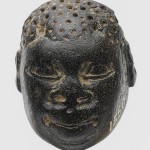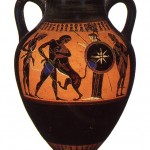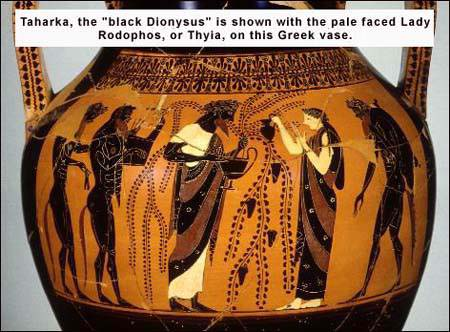
By Jide Uwechia with cited sources
The Benin Haplogroup or Haplogroup 19 Common in Africans, southern Greeks, Sicilians, and Albanians
There are at least four distinct African, (known as Senegal, Congo, Benin, Bantu Hbs Haplogroups) and one Asian chromosomal backgrounds (haplotypes) on which the sickle cell mutation has arisen.
The Benin haplotype (which originates from Nigeria, West Africa) accounts for HbS associated chromosomes in Sicily Northern Greece, Southern Turkey, and South West Saudi Arabia, suggesting that these genes had their origin in West Africa. The Asian haplotype is rarely encountered outside its geographic origin because there have been few large population movements and Indian emigrants have been predominantly from non HbS containing populations. Per:Graham R. Serjeant, MD, FRCP, The Geography Of Sickle Cell Disease:Opportunities For Understanding Its DiversityRSITY: http://www.kfshrc.edu.sa/annals/143/rev9239.html
Nigeria, west Africa appears the most logical origin of the sickle mutation in Greece evidence from beta S globin gene cluster polymorphisms (1991). It has been conclusively demonstrated that HbS in Greece is mostly haplotype #19 (the one that originated in Benin, Nigeria West Africa). See, Boussiou M, Loukopoulos D, Christakis J, Fessas P.; The origin of the sickle mutation in Greece; evidence from beta S globin gene cluster polymorphisms. Unit for Prenatal Diagnosis, Laikon Hospital, Athens, Greece.
Additionally, previous data suggest that the S/Bantu haplotype (from Southern Africa) is heterogeneous at the molecular level. Recent studies also report a similar heterogenity for the Benin Haplogroup. A study demonstrated the presence of the A -499 TA variation in sickle cell anemia chromosomes of Sicilian and North African origin bearing the S/Benin haplotype (from Nigeria). Being absent from North American S/Benin chromosomes, which were studied previously, this variation is indicative for the molecular heterogeneity of the S/Benin haplotype. Am. J. Hematol. 80:79-80, 2005.
A study was done in Albania (which borders Greece) relating to sickle cell anemia, sickle cell beta-thalassemia, and thalassemia major in Albania. The focus of the study was the characterization of sickle cell mutations. As one would expect, it was shown that the HbS mutation in the Albanian sample is the Benin (Nigeria)-originating haplotype #19. See, Boletini E, Svobodova M, Divoky V, Baysal E, Dimovski AJ, Liang R, Adekile AD, Huisman TH.; Sickle cell anemia, sickle cell beta-thalassemia, and thalassemia major in Albania: characterization of mutations. : Hum Genet. 1994 Feb;93(2):182-7.
According to a study done in 1973, before the availability of the advanced data cited above, “the occurrence of the sickle-cell trait in southern Europe …. is believed to reflect gene flow from the Middle East.” See A. P. GELPI, M.D, “Migrant Populations and the Diffusion of the Sickle-Cell Gene” August 1, 1973 vol. 79 no. 2 258-264 http://www.annals.org/content/79/2/258.abstract.
The problem with this 1973 study is that it assumes that the sickle cell genes came with the Arabs. Alas, updated research work has proven beyond doubt that the sickle cell genes proven to exist in southern Europe are exclusively Sickle cell gene Haplotype 19 or the Benin Sickle cell gene from Nigeria.
Y Haplogroup E-M78 and YAP In Black Africans and Greeks
Y Haplogroup E-M78 a derivative of E3B is a signature African gene as confirmed in research studies over the last few years. The high frequency of this haplogroup in Greece suggests the presence of a substantive African population in that region during prehistoric and historical time periods.
A recent paper has detected clades of haplogroups J and E3b that were likely not part of pre-historic migrations into Europe, but rather spread by later historical movements. Greeks .. [then there is] the marker J-M267, which may reflect more recent Middle Eastern admixture.
(Semino et al., Am J Hum Genet, 2004) E3b originates from East Africa while there is a high frequency of J-M267 in the East Coast of Africa as well as the Red sea coast of Arabia.
A recent sampling of the Greek population comprised 36 Peloponnesian samples, 5 of which were J-M172(xM12) and 17 of which were E-M78 (R.K., unpublished data).
In spite of the small Peloponnesian sample size, the high E-M78 frequency (47%) observed here is consistent with that (44%) independently found in the same region (Di Giacomo et al. 2003) for the YAP chromosomes harboring microsatellite haplotypes A. (Novelletto, personal communication) (Cruciani et al. 2004).
The study by by Di Giacomo et al. found the following African haplogroups in Greeks: Haplogroup A which is highly specific to West Africa, R1a, DE, and J2*(xDYS413= 18)J*(xJ2). R1* which probably gave rise to R1a is found in Northern Cameroon. DE is found principally among Nigerians and it is suspected that it originated from Nigeria. J is very prominent in East, and North Africa.
High-resolution Y-chromosome haplotyping and particular microsatellite associations reveal … an East Africa homeland for E-M78.Origin. See Ornella Semino, Chiara Magri, et al “Diffusion, and Differentiation of Y-Chromosome Haplogroups E and J: Inferences on the Neolithization of Europe and Later Migratory Events in the Mediterranean Area” http://www.pubmedcentral.nih.gov/articlerender.fcgi?tool=pubmed&pubmedid=15069642
HLA Genetic Relationship Between Ancient Greeks and Black Africans
HLA genes are reliable markers of past population movement and are still used in laboratories today to establish genetic inter-relationship amongst seemingly diverse peoples.
HLA genes in Macedonians and the sub-Saharan origin of the Greeks (2001) was a study conducted by Dr. Arniaz and other scholars in a top flying Spanish University. This study uses HLA genes to establish the African dimension of the roots of ancient Greece.
According to the Arniaz study, …Greeks are found to have a substantial relatedness to sub-Saharan (Ethiopian) people, which separate them from other Mediterranean groups. Both Greeks and Ethiopians share quasi-specific DRB1 alleles, such as *0305, *0307, *0411, *0413, *0416, *0417, *0420, *1110, *1112, *1304 and *1310. Genetic distances are closer between Greeks and Ethiopian/sub-Saharan groups than to any other Mediterranean group and finally Greeks cluster with Ethiopians/sub-Saharans in both neighbour joining dendrograms and correspondence analyses. The time period when these relationships might have occurred was ancient but uncertain and might be related to the displacement of Egyptian-Ethiopian people living in pharaonic Egypt. See Arnaiz-Villena A, et.al: HLA genes in Macedonians and the sub-Saharan origin of the Greeks. Tissue Antigens. 2001 Feb; 57(2): 118-27
There is a fraudulent claim (by those with idealogical investments in the topic) on the Internet that this study has been “retracted” or “refuted.” The study is perfectly valid. Sub-Saharan-specific and quasi-sub-Saharan-specific alleles were definitely detected in the Greek population at the DRB1 locus, and this is not open to question.
It would be helpful here to discuss the study that was retracted, and the reason why. It is the work titled: “The origin of Palestinians and their genetic relatedness with other Mediterranean populations” (which contained some cross-referenced Greek data in a neighbor-joining dendogram and a correspondence analysis) that was retracted. And it was retracted solely and strictly for political reasons, as this Observer article makes crystal clear:
http://www.guardian.co.uk/Archive/Article/0,4273,4307083,00.html
(Keep in mind we are dealing with the study on the relatedness of Jews and Palestinians at the moment, which was retracted, and not the one on the Greek-Black African relatedness, which was not retracted and remains valid. The two must not be confused.)
Appreciations to: http://onedroprule.org/about1071.html
Epilogue:
“Hb S is common in some areas of the Mediterranean basin, including regions of Italy, Greece, Albania and Turkey (Boletini et al., 1994) (Schiliro et al., 1990). Haplotype analysis shows that the Hb S in these areas originated in Africa. The genes probably moved along ancient trading routes between wealthy kingdoms in western Africa and the trade centers in the Mediterranean basin.” (Harvard University, http://sickle.bwh.harvard.edu/scdmanage.html)
“Usually, people with sickle cell disease outside Africa (e.g., blacks in the United States) or India have mixed haplotypes for their sickle cell genes.” (Harvard University, http://sickle.bwh.harvard.edu/scdmanage.html)
“Templeton gives a modern-day analogy: the presence of a gene for sickle cell anemia in Caucasians in Portugal. The gene traces back to a mutation that occurred in Africa and spread through interbreeding between Africans and Europeans. “The Africans didn’t come up, reconquer the Iberian peninsula, kill off all the Europeans, and that’s why there are sickle cell alleles in Portugal today,” he says. The presence of the sickle cell gene in Portugal “means that Portuguese and Africans have met and they’ve interbred, just like humans tend to do.” – “Out of Africa” – Ruth Flanagan, Contributing Editor, Earth Magazine, http://www2.mc.maricopa.edu/anthro/l…ofAfrica5.html




Mr. Recombined Y-DNA
But you just demonstrated that you have no clue what you are talking about.
Jahdey roars with laughter LOL!!!:
GENETICS 101
The genealogical usefulness of these two DNA tests is based on some special aspects of human inheritance:
> that the Y chromosome is passed on only by the father;
> that mitochondria are passed on only by the mother, and
> that neither Y-DNA nor mtDNA engages in recombination.
http://dgmweb.net/genealogy/DN…..tion.shtml
You made a fatal error. Hear yourself again:
Dave continues to babble:
They are talking about a new molecular(Genetic recombination, the process by which a strand of genetic material is broken and then joined to a different DNA molecule.
Jahdey continues to laugh the laugh of a babbling fool all the while STILL not understanding what scientists actual are talking about when it comes to genetic. Since you don’t have a clue I suggest you read up on the concept of a single locus and genetic variation over a very long period of time.
This is very hot subject on the Balkans
First think MACEDONIANS WERE NOT GREEKS, it is proven with DNA analises
there were speaking difrent languages difrent people
Macedonians Blond Greeks Darker
You need more proves
Macedonians come from Asia Greeks from Africa
u first think that u have not any comon or realation with the ancient greek tribe o macedonians because you are a mixture split by bulgarians and south slavs after 5th century a.D. . Of course u came from Asia but not as descedant of ancient Macedonians but as a descedant of mongoloid Tataria like your Pakis and mongols and Turks. Just watch your state constract with 1.000.000 Albanians and 300.000 Turkogypsies. Whose the lighter? The black head of Skopje (albanian city) Fuck off.. and go back to Tataria.
Just to let you know, that HLA study was shown to be incorrect to two later HLA studies and a 120 SNP study that showed Greeks to be typically European. An odd choice, the only dna study that’s been publicly ridiculed and then proved to be wrong, as your basis for a case.
Mt and Y DNA in Europe from West Africa are virtually nil. Read some scientic papers, the sickle cell variant is highly affected by natural selection and the Nigerian variant is thought to have enetered S Euorpe from the North African population, as tthey have it too; there’s so lttle DNA traceable to west africa that no-one could make a case to support it
Sachat
HLA analysis has formed the basis of genetic research for decades now in the domain of clinical medicine. HLA genetic analysis is a currently validated research methodology for tracking diseases, for confirming interrelatedness of different populations over all the world. You should go do some research. See also, http://www.google.ca/search?hl=en&q=HLA+genetic+analysis+&meta=
You just admitted that the Nigerian variant of the HBS gene is found widely in southern Europe. That it entered Europe from North Africa is a no-brainer because any time one travels overland from Nigeria to Southern Europe one must pass through North Africa.
In addition to all this, Male HG E3B gene, A or T, and the percursor to R1B is found in Cameroon as R*.
Elsewhere on this website I have advised you to go study before you display your vacuity for the whole world. Take the advice seriously.
Jahdey
There was nothing ‘accurate’ about that foolish “HLA study “, if anyone bothered to read it, which obviously none of you did, that same dubious ‘study’ also claims Ancient Egyptians were more related to Slav EUROPEANS then any African people. Check out WHERE they cluster ancient Egyptians with: white people that defies not only geographical and historical facts while they wrongly cluster Greeks were are white with black people. Speaks volumes of propaganda not scientific facts.
Oh and ‘Alexander’ with the Greek name, Macedonians WERE too GREEKS.
No psteve321, you are in delusion. The article is not only citing the HLA study. The Article cited more than 50 different studies on the inter-relatedness of Greeks and Africans. Read the footnotes. Read the other citations.
Besides, if you actually read the HLA research itself, then you would understand that your master’s at those racist websites that you visit who lie to you, did it again this time.
Go read that research and come tell me with references and citations from the article, wherein the author went wrong.
Otherwise you are deluded!
Jahdey, it is clear after reading all these arguments that you do not have the skills to critically analyze information. It appears your only skill is finding links to internet sites and quoting the sections that you feel are relevant to support your argument. In order make a valid contribution at an academic level you need to absorb all the information, not just snippets. In summary you are a fool…
And Mr. SmartAss, bring on your “scholarly” arguments then. I will demolish them and humiliate you like I have done to all the other inconsequential puppies like you.
Roar!!!!
Jahdey
“pristine” E3b (now called E1b1b) arose in sub saharan East Africa, probably the horn around 25,000 years ago or so….E-M78 (which derives from pristine E3b) arose in East Africa as well, and entered SouthEAstern Europe during the Neolithic or Mesolithic. About 85% of Greek E3b is the “:alpha cluster” E-V13 which arose and dispersed further West and North from the Balkans. Anyways, none of those mutations negate descent. The Ancient Greeks indeed did carry lineages that originated in East Africa…there is no getting around that, period. They also carried haplogroup J2 to a large degree as well, J2 first arose around Mesopotamian…together those 2 lineages accounted for probably 60% of ancient Greek Y chromosome lineages. Others being R1b, I2, and perhaps a little bit of R1a and K.
The American Journal of Human genetics considers both J2 and E-M78 to be “Greek signature lineages” of the ancient Greeks colonizing Southern Italy.
“Southern Italy (Apulia and Calabria) contains sites of the early Neolithic period (Whitehouse 1968), but we know from history that these regions were subsequently colonized by the Greeks (Peloponnesians). To test the relative contribution of Greek colonists versus putative earlier Neolithic settlers, an admixture analysis (Bertorelle and Excoffier 1998) was performed, using E-M78 and J-M172(xM12) as signatures of Greek and Anatolian lineages, respectively.”
SOURCE
Semino et al. (2004) Origin, Diffusion, and Differentiation of Y-Chromosome Haplogroups E and J: Inferences on the Neolithization of Europe and Later Migratory Events in the Mediterranean Area. Am J Hum Genet
As far Sickel Cell goes, well it’s impossible to tell how much of it in Europe is due to what sort of migrations…however the bulk of sickle Cell in Europe is probably from the Neolithic. Sickle Cell is much higher in Sicily/Southern Italy, and Greece than it is in Spain…and Spain has had much more direct contacts with Africa in historic times.
Genetic evidence for Sickle Cell being carried by neolithic farmers.
“This migration finds some support in the presence in Mediterranean populations (Sicily, Greece, southern Turkey, etc.; Patrinos et al. 2001; Schiliro et al. 1990) of the Benin sickle cell haplotype. This haplotype originated in West Africa and is probably associated with the spread of malaria to southern Europe through an eastern Mediterranean route (Salares et al. 2004) following the expansion of both human and mosquito populations brought about by the advent of the Neolithic transition”
SOURCE
Cranial Discrete Traits in a Byzantine Population and Eastern Mediterranean Population Movements. Human Biology , Oct 2008 by Ricaut, F X, Waelkens, M
Osteological evidence of Benin Sickle Cell in neolithic and ancient Greeks, including “Royal graves”.
“Throughout this whole area…a manifestation of disease, once called ‘osteoporosis symmetrica’ occurs in ancient skeletons. It is a porotic hyperostosis of the skulls and other bones…. In the Mediterranean, porotic hyperostosis probably represents thalassemia or SICKLEMIA….”
“From this standpoint it is important to note that in Greece all the adult frequencies of hyperostosis change thus: Mesolithic 40%, Early Neolithic 60%, Late Neolithic-Early Bronze Age 28%, Middle Bronze 13%, Royal Graves 8%, Late Bronze 8%, Early Iron 4%, Hellenistic 10%, Roman 24%, Medieval 12%, Turkish 45%, Romantic 37%.”
“But a steady decrease in thalassemia from first farmers to the 4th c. BC would fit the probabilities expected from increasingly efficient use of farmland and swamp-drainage…. The subsequent rather quick increase would fit the evidence amassed by Jones (1907, 1909) and Stephanos (1884), and their successors, showing that malaria became endemic and then fluctuated somewhat in severity down to modern times.”
SOURCE
Angel, J. Lawrence. The People of Lerna: Analysis of a Prehistoric Aegean Population. American School of Classical Studies, Athens, 1971
Btw I am Greek and I am also interested in genetics and bio-history, especially of the East Mediterranean area.